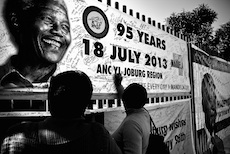A Legacy of Reconciliation

Thomas J. Stipanowich , professor of law and the academic director of the Straus Institute for Dispute Resolution at Pepperdine University reflects on Mandela's legacy.
Photo Courtesy of Andrea Cavallini (Flickr, cavallotdk): "Mandela" -- CC: BY-NC 2.0
Eddie Daniels and I were standing in Nelson Mandela's cell at Robben Island Maximum Security Prison.
Now a World Heritage site and museum, Robben Island was not so long ago known as the
Devil's Island of South Africa. It was a hard and frightening place where convicted
terrorists and saboteurs—fighters against apartheid—were imprisoned. That is, the
non-white ones like Nelson Mandela and his co-prisoner Eddie Daniels.
We were standing there in Mandela's cell, the small, bare enclosure where he spent 18 years. Standing there, just as Mandela and other prisoners were made to do all day long, every day, when they weren't engaged in hard labor. Not sitting, not lying, but standing.
It was winter, and the pervasive chill made me grateful for my warm sweater and overcoat. Eddie explained that Mandela and all other African prisoners were issued shorts and sandals, and were required to wear these in all kinds of weather. They slept on thin mats on the bare concrete, and relieved themselves in small metal buckets.
Eddie Daniels and Nelson Mandela were on Robben Island together for 15 years. Both had fought against the pervasive system of injustice that was apartheid. In the 1950s, Eddie had followed the lead of Mandela and others in adopting Gandhi's nonviolent approach in challenging apartheid, conducting protests and sit-ins in whites-only clubs and premises. Though light-skinned, Eddie was of mixed parentage and officially categorized as "colored." But, believing in the equality of all races, he labeled himself a "black" in solidarity with those who were subject to the most stringent and punitive of regulations. He did not join Mandela's African National Congress (ANC), however, because he thought it placed too much emphasis on racial differences.
In the wake of the 1960 massacre of dozens of Africans by government soldiers at Sharpeville, the ANC made the decision to embrace armed struggle against the apartheid regime. Daniels joined a smaller illegal organization, the African Resistance Movement (ARM). Its members conducted sabotage against government installations, taking great care to avoid injuring human beings.
In 1964 Eddie and other ARM members were informed upon. They were picked up, detained, isolated, and tortured. After months of confinement, he was charged with sabotage, convicted, and sentenced to 15 years of hard labor.
Shipped in a black, stinking hold to Robben Island, Eddie was confronted by a tall, formidable man who extended his hand, smiled and said, "I'm Nelson." It was Mandela, who had been sentenced to life imprisonment for terrorism along with other leaders of the ANC. Eddie was dumbfounded that the leader of the primary resistance group against apartheid, the man he called "the point of the spear," would deign to show him, a mere foot soldier in the anti-apartheid ranks, such courtesy. But Mandela befriended him, taking the time to keep him informed of developments "on the outside." And when Eddie was lying sick in his cell, it was Mandela who came and sat on the concrete floor beside him, comforted him, and took his metal waste bucket down the hall and cleaned it out.
Eddie Daniels was released from Robben Island Prison in November, 1979. Thanks to international pressure by the Red Cross and other organizations, conditions had improved mightily at the prison. During his later years there Eddie even managed to obtain educational credentials. He eventually went to university and qualified to be a teacher.
Years later, Eddie watched as his prison mate Nelson Mandela, the voice of reconciliation, brought his country back from the brink of civil war. In 1994 Eddie celebrated with other fellow Robben Island inmates when Mandela became South Africa's first black president. Eddie Daniels and Nelson Mandela would remain lifelong friends.
In 1980, shortly after his release from Robben Island, Eddie received a letter of apology from the friend who betrayed and gave evidence against him. Eddie responded with a long and thoughtful message that combined extraordinary objectivity and empathy. While bemoaning the seriousness of his former friend's lapse, he concluded, "I personally have no grudge against you. I hope that this letter will help you to find mental peace. I also wish you happiness for the future."
Like Nelson Mandela, Eddie Daniels found it within himself to move beyond the sufferings
and wrongs of the past and unburden his heart of hate and the desire for vengeance.
Theirs is the ultimate lesson we may glean from the South African experience.
JANUARY 2014